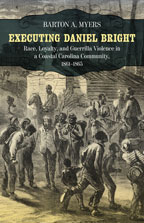
216 pages / 5.50 x 8.50 inches / 5 halftones, 1 map
History / United States - Civil War Period
On December 18, 1863, just north of Elizabeth City in rural northeastern North Carolina, a large group of white Union officers and black enlisted troops under the command of Brigadier General Edward Augustus Wild executed a local citizen for his involvement in an irregular resistance to Union army incursions along the coast. Daniel Bright, by conflicting accounts either a Confederate soldier home on leave or a deserter and guerrilla fighter guilty of plundering farms and harassing local Unionists, was hanged inside an unfinished postal building. The initial fall was not mortal, and according to one Union soldier's account, Bright suffered a slow death by "strangulation, his heart not ceasing to beat for twenty minutes."
Until now, Civil War scholars considered Bright and the Union incursion that culminated in his gruesome death as only a historical footnote. In Executing Daniel Bright, Barton A. Myers uses these events as a window into the wider experience of local guerrilla conflict in North Carolina's Great Dismal Swamp region and as a representation of a larger pattern of retaliatory executions and murders meant to coerce appropriate political loyalty and military conduct on the Confederate homefront. Race, political loyalties, power, and guerrilla violence all shaped the life of Daniel Bright and the home he died defending, and Myers shows how the interplay of these four dynamics created a world where irregular military activity could thrive.
Myers opens with an analysis of antebellum slavery, race relations, slavery debates, and the role of the environment in shaping the antebellum economy of northeastern North Carolina. He then details the emergence of a rift between Unionist and Confederate factions in the area in 1861, the events in 1862 that led to the formation of local guerrilla bands, and General Wild's 1863 military operation in Pasquotank, Camden, and Currituck counties. He explores the local, state, regional, and Confederate Congress's responses to the events of the Wild raid and specifically to Daniel Bright's hanging, revealing the role of racism in shaping those responses. Finally, Myers outlines the outcome of efforts to negotiate neutrality and the state of local loyalties by mid-1864.
Revising North Carolina's popular Civil War mythology, Myers concludes that guerrilla violence such as Bright's execution occurred not only in the highlands or Piedmont region of the state's homefront; rather, local irregular wars stretched from one corner of the state to the other. He explains how violence reshaped this community and profoundly affected the ways loyalties shifted and manifested themselves during the war. Above all, Myers contends, Bright's execution provides a tangible illustration of the collapse of social order on the southern homefront that ultimately led to the downfall of the Confederacy.
Microhistory at its finest, Executing Daniel Bright adds a thought-provoking chapter to the ever-expanding history of how Americans have coped with guerrilla war.
Barton A. Myers is an associate professor of history at Washington and Lee University. He is the author of Executing Daniel Bright: Race, Loyalty, and Guerrilla Violence in a Coastal Carolina Community, 1861-1865 and Rebels Against the Confederate: North Carolina's Unionists.
For more information visit http://www.bartonamyers.com/
"Executing Daniel Bright is microhistory at its finest... Barton's study is especially effective in showing how the traditional framework of nationalism and Confederate identity does not often address how ordinary people crafted everyday strategies of survival in a revolutionary war that often demanded pragmaticism more than idealism."
Peter S. Carmichael, American History 39
"What Myers has shown about the vicious, vengeful nature of guerrilla warfare is as impressive as it is sobering...Myers has also proven that for many residents of northeastern North Carolina local loyalties – concern for family members, for ways of making a living, and for the stability of the neighborhood – were more important than Confederate independence or the preservation of the Union. " [read full review]
Paul Escott, Civil War Book Review
"This fine piece of microhistory shows why guerrilla conflict became a decisive factor in determining the loyalties of many wartime southerners. While the details varied from place to place, Myers' intricate tale of race, revenge, and intimidation in North Carolina leaves no doubt that local circumstances and the threat of personal ruin, as often as grand armies and pitched battles, ruled the day."---Daniel E. Sutherland, author of A Savage Conflict: The Decisive Role of Guerrillas in the American Civil War
Found an Error? Tell us about it.